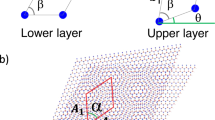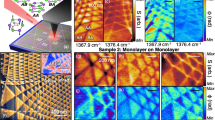Abstract
Twisting or sliding two-dimensional crystals with respect to each other gives rise to moiré patterns determined by the difference in their periodicities. Such lattice mismatches can exist for several reasons: differences between the intrinsic lattice constants of the two layers, as is the case for graphene on BN1; rotations between the two lattices, as is the case for twisted bilayer graphene2; and strains between two identical layers in a bilayer3. Moiré patterns are responsible for a number of new electronic phenomena observed in recent years in van der Waals heterostructures, including the observation of superlattice Dirac points for graphene on BN1, collective electronic phases in twisted bilayers and twisted double bilayers4,5,6,7,8, and trapping of excitons in the moiré potential9,10,11,12. An open question is whether we can use moiré potentials to achieve strong trapping potentials for electrons. Here, we report a technique to achieve deep, deterministic trapping potentials via strain-based moiré engineering in van der Waals materials. We use strain engineering to create on-demand soliton networks in transition metal dichalcogenides. Intersecting solitons form a honeycomb-like network resulting from the three-fold symmetry of the adhesion potential between layers. The vertices of this network occur in bound pairs with different interlayer stacking arrangements. One vertex of the pair is found to be an efficient trap for electrons, displaying two states that are deeply confined within the semiconductor gap and have a spatial extent of 2 nm. Soliton networks thus provide a path to engineer deeply confined states with a strain-dependent tunable spatial separation, without the necessity of introducing chemical defects into the host materials.
This is a preview of subscription content, access via your institution
Access options
Access Nature and 54 other Nature Portfolio journals
Get Nature+, our best-value online-access subscription
$29.99 / 30 days
cancel any time
Subscribe to this journal
Receive 12 print issues and online access
$209.00 per year
only $17.42 per issue
Buy this article
- Purchase on Springer Link
- Instant access to full article PDF
Prices may be subject to local taxes which are calculated during checkout




Similar content being viewed by others
Data availability
Source data are provided with this paper. All other data that support the plots within this paper and other findings of this study are available from the corresponding author upon reasonable request.
References
Dean, C. R. et al. Hofstadter’s butterfly and the fractal quantum Hall effect in moiré superlattices. Nature 497, 598–602 (2013).
Li, G. et al. Observation of van Hove singularities in twisted graphene layers. Nat. Phys. 6, 109–113 (2009).
Alden, J. S. et al. Strain solitons and topological defects in bilayer graphene. Proc. Natl Acad. Sci. USA 110, 11256–11260 (2013).
Cao, Y. et al. Unconventional superconductivity in magic-angle graphene superlattices. Nature 556, 43–50 (2018).
Cao, Y. et al. Correlated insulator behaviour at half-filling in magic-angle graphene superlattices. Nature 556, 80–84 (2018).
Yankowitz, M. et al. Tuning superconductivity in twisted bilayer graphene. Science 363, 1059–1064 (2019).
Sharpe, A. L. et al. Emergent ferromagnetism near three-quarters filling in twisted bilayer graphene. Science 365, 605–608 (2019).
Liu, X. et al. Spin-polarized correlated insulator and superconductor in twisted double bilayer graphene. Preprint at https://arxiv.org/pdf/1903.08130.pdf (2019).
Seyler, K. L. et al. Signatures of moiré-trapped valley excitons in MoSe2/WSe2 heterobilayers. Nature 567, 66–70 (2019).
Tran, K. et al. Evidence for moiré excitons in van der Waals heterostructures. Nature 567, 71–75 (2019).
Jin, C. et al. Observation of moiré excitons in WSe2/WS2 heterostructure superlattices. Nature 567, 76–80 (2019).
Alexeev, E. M. et al. Resonantly hybridized excitons in moiré superlattices in van der Waals heterostructures. Nature 567, 81–86 (2019).
Woods, C. R. et al. Commensurate–incommensurate transition in graphene on hexagonal boron nitride. Nat. Phys. 10, 451–456 (2014).
Kumar, H., Dong, L. & Shenoy, V. B. Limits of coherency and strain transfer in flexible 2D van der Waals heterostructures: formation of strain solitons and interlayer debonding. Sci. Rep. 6, 21516 (2016).
Carr, S. et al. Relaxation and domain formation in incommensurate two-dimensional heterostructures. Phys. Rev. B 98, 224102 (2018).
Naik, M. H. & Jain, M. Ultraflatbands and shear solitons in moiré patterns of twisted bilayer transition metal dichalcogenides. Phys. Rev. Lett. 121, 266401 (2018).
Huang, S. et al. Topologically protected helical states in minimally twisted bilayer graphene. Phys. Rev. Lett. 121, 037702 (2018).
Yoo, H. et al. Atomic and electronic reconstruction at the van der Waals interface in twisted bilayer graphene. Nat. Mater. 18, 448–453 (2019).
Kerelsky, A. et al. Maximized electron interactions at the magic angle in twisted bilayer graphene. Nature 572, 95–100 (2019).
Ju, L. et al. Topological valley transport at bilayer graphene domain walls. Nature 520, 650–655 (2015).
Yankowitz, M. et al. Electric field control of soliton motion and stacking in trilayer graphene. Nat. Mater. 13, 786–789 (2014).
Jiang, L. et al. Manipulation of domain-wall solitons in bi- and trilayer graphene. Nat. Nanotechnol. 13, 204–208 (2018).
Edelberg, D. et al. Approaching the intrinsic limit in transition metal diselenides via point defect control. Nano Lett. 19, 4731–4739 (2019).
Cooper, R. C. et al. Nonlinear elastic behavior of two-dimensional molybdenum disulfide. Phys. Rev. B 87, 035423 (2013).
Pokrovsky, V. L. & Talapov, A. L. Ground state, spectrum and phase diagram of two-dimensional incommensurate crystals. Phys. Rev. Lett. 42, 65–67 (1979).
Levy, N. et al. Strain-induced pseudo-magnetic fields greater than 300 tesla in graphene nanobubbles. Science 329, 544–547 (2010).
Cazalilla, M. A., Ochoa, H. & Guinea, F. Quantum spin Hall effect in two-dimensional crystals of transition-metal dichalcogenides. Phys. Rev. Lett. 113, 077201 (2014).
Chirolli, L., Prada, E., Guinea, F., Roldán, R. & San-Jose, P. Strain-induced bound states in transition-metal dichalcogenide bubbles. 2D Mater. 6, 025010 (2019).
Shen, T., Penumatcha, A. V. & Appenzeller, J. Strain engineering for transition metal dichalcogenides based field effect transistors. ACS Nano 10, 4712–4718 (2016).
Zhang, C. et al. Interlayer couplings, moiré patterns, and 2D electronic superlattices in MoS2/WSe2 hetero-bilayers. Sci. Adv. 7, e1601459 (2017).
Pan, Y. et al. Quantum-confined electronic states arising from the moiré pattern of MoS2–WSe2 heterobilayers. Nano Lett. 18, 1849–1855 (2018).
Liu, G.-B., Shan, W.-Y., Yao, Y., Yao, W. & Xiao, D. Three-band tight-binding model for monolayers of group-VIB transition metal dichalcogenides. Phys. Rev. B 88, 085433 (2013).
Wieteska, A. et al. Uniaxial strain tuning of superconductivity in 2H-NbSe2. Preprint at https://arxiv.org/abs/1903.05253 (2019).
Acknowledgements
This work was supported by the National Science Foundation (NSF) via grant no. DMR-1610110 (to D.E.) and by the NSF MRSEC programme through Columbia in the Center for Precision Assembly of Superstratic and Superatomic Solids (DMR-1420634; to H.O. and A.N.P.). Support for STM measurements was provided by the Air Force Office of Scientific Research (grant no. FA9550-16-1-0601). The computational work was supported primarily by contract W911NF-16-1-0447 from the Army Research Office (to V.B.S.) and by grant no. CMMI-1727717 (to H.K.) from the NSF.
Author information
Authors and Affiliations
Contributions
D.E. performed STM experiments under the guidance of A.N.P. H.K. performed density functional theory and molecular dynamics simulations under the guidance of V.S. H.O. performed analytical calculations. D.E., H.O. and A.N.P. wrote the manuscript with assistance from H.K. and V.S.
Corresponding authors
Ethics declarations
Competing interests
The authors declare no competing interests.
Additional information
Publisher’s note Springer Nature remains neutral with regard to jurisdictional claims in published maps and institutional affiliations.
Supplementary information
Supplementary Information
Supplementary Table 1, Figs. 1–6 and Discussion.
Source data
Source Data Fig. 2
Source data for Fig. 2b,c.
Source Data Fig. 4
Source data for Fig. 4a,b(plus inset),f.
Rights and permissions
About this article
Cite this article
Edelberg, D., Kumar, H., Shenoy, V. et al. Tunable strain soliton networks confine electrons in van der Waals materials. Nat. Phys. 16, 1097–1102 (2020). https://doi.org/10.1038/s41567-020-0953-2
Received:
Accepted:
Published:
Issue Date:
DOI: https://doi.org/10.1038/s41567-020-0953-2
This article is cited by
-
Engineering interfacial polarization switching in van der Waals multilayers
Nature Nanotechnology (2024)
-
Engineering interlayer hybridization in van der Waals bilayers
Nature Reviews Materials (2024)
-
Moiré straintronics: a universal platform for reconfigurable quantum materials
npj 2D Materials and Applications (2023)
-
In-situ atomic level observation of the strain response of graphene lattice
Scientific Reports (2023)
-
Water nanolayer facilitated solitary-wave-like blisters in MoS2 thin films
Nature Communications (2023)



